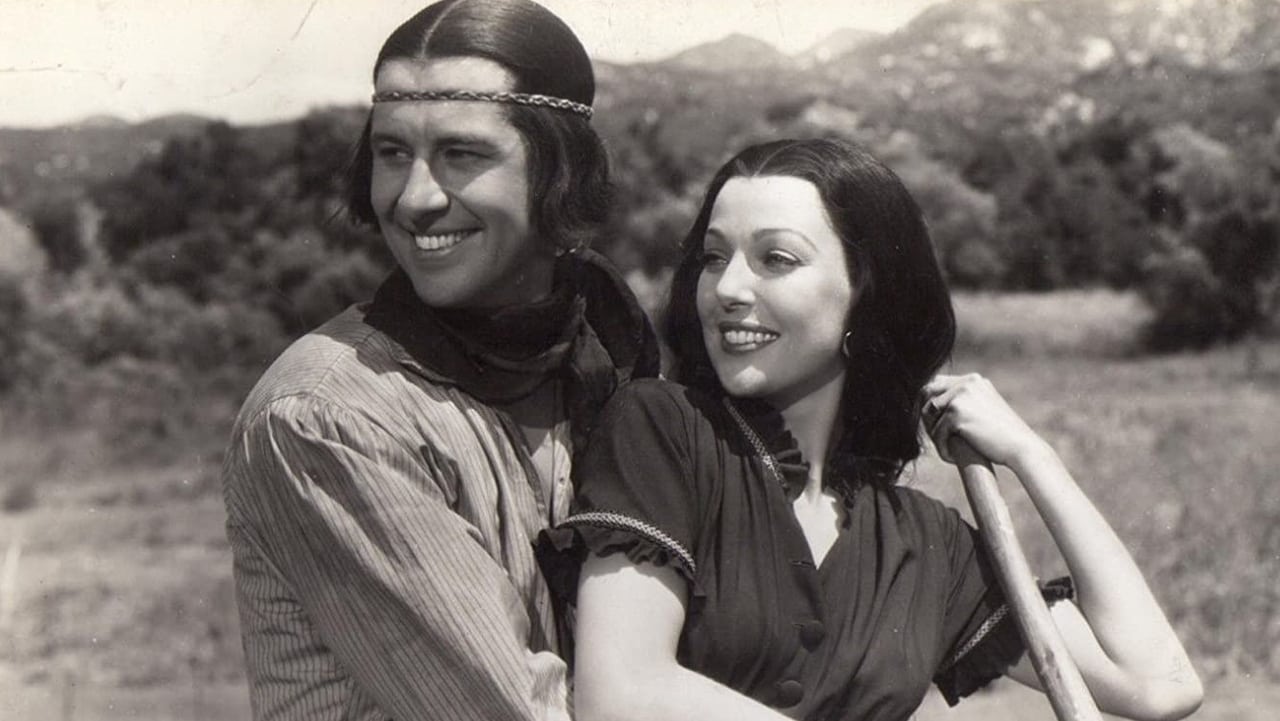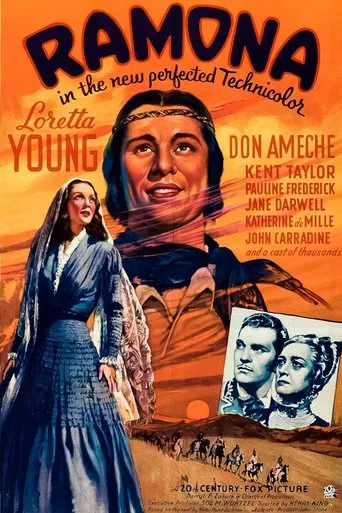

You have a choice to make. You can fret about Don Ameche playing an Indian and let it ruin the film for you. Or you can just accept that in 1936 there wasn't going to be a full blooded Indian in a leading role of an important motion picture. In other words, get over it.This film is based on a very important novel about racial prejudice, and while I have not read the novel, my impression is that to quite an extent the movie is a too-simplified version of the story. However, racial prejudice in an underlying and ongoing theme of this film, so it still has impact.The other important thing about this film is that it was only the fourth movie to be filmed in 3-strip Technicolor! Unfortunately, the print is not pristine, but the Technicolor is still quite stunning, including with lots of outdoor scenes "on location" in sunny California.Loretta Young was a lovely actress, and her performance here is excellent. Don Ameche, a much forgotten actor, was a fine performer, although here he seems perhaps a bit too refined to be a Spanish-Indian of that period. I don't know that...I'm just surmising. He's still interesting to watch. The other performance of note here is by Jane Darwell, whom most viewers will recall from "The Grapes Of Wrath".When you think of the advances in Technicolor from this film in 1936 to "Gone With The Wind" 3 years later...wow! The film does seem dated, but I think it's worth it to watch an historically important novel turned into a film, with themes that still resonate in our culture today.
... View MoreI have to concede that this picture had me constantly off balance. It began with the relationship between Ramona Moreno (Loretta Young) and her brother Felipe (Kent Taylor). Didn't it seem like they were just a little too lovestruck to be brother and sister before Alessandro (Don Ameche) came on the scene? Felipe was definitely looking to take the relationship to a different level before he learned of Ramona's background, but even so, they would have been raised as siblings. The whole thing didn't compute with me.Then there was the casting of Don Ameche as an Indian. That might not have been so bad but with the way his hair was restrained by the headband he looked like Andy Kaufman to me. Upon his very first meeting with Ramona hanging from the apple tree, all I could do was wonder how she got up there in the first place. Stop and think about that for a minute.So when Ramona finally confessed her love to Alessandro it just seemed like it came out of left field. They get married and with a quick scene change they already have a baby. After getting kicked off their land by the white settlers, they're taken in by a pioneer family for a time, but even there, Aunt Ri Hyar (Jane Darwell) goes through a brief moment of racist resentment before figuring the couple is OK.I guess what I'm saying is that all these situations probably needed a bit more development in the story to make sense, but instead they occurred almost as random events with no sense of continuity. On the plus side, Loretta Young made for a quite lovely leading lady with a genuinely wholesome charm for the era. Her appearance in the story is the only reason I can come up with to catch this picture, otherwise you can give it a bye.
... View MoreThere are legendary moments in Hollywood history where somebody is so blatantly miscast that the results are ridiculous. In most cases, the fault is not the actors, but in a few (most memorably, John Wayne as Ghengis Khan in "The Conquerors"), there is no place else to point the finger. In 1936, Hollywood cast Don Ameche and Loretta Young as "Native Americans" (or "Indians" as they refer to themselves here), simply darkening their skin while giving them black wigs or shoe polish to change their appearance. This was Ameche's first leading role, but Young had been a major star since the beginning of talkies. Of course, the roles were obviously challenging, and both stars give their best to make their characters as real as possible. But 78 years later, their casting raises eyebrows and creates a lot of controversy over the so-called "Golden Years" of Hollywood.In spite of that, this is a riveting movie that you can enjoy if you simply just get past the fact that Ameche, no matter what his background was, came off as too All-American and that Young, even if playing only partial "Native", was as Caucasian as they come. Had the film been made in black and white, their appearances wouldn't transcend the character's nationalities. Yet, being only one of several films made in color that year ("The Trail of the Lonesome Pine" also came out), "Ramona" is still striking to look at, and there are moments when you see that the script really is taking great pains to show sympathy to the people whose land our forefathers stole from underneath them. In fact, that is what is going on here. Landgrabbers come to California, are willing to kill to get their hands on the precious soil already planted on, and Ameche, Young and their baby girl are displaced with no place to go. A pattern in history to be sure. Just look at "Fiddler on the Roof".Ramona is the beautiful heroine, a young girl unaware even in spite of the fact that she looks "native" (or is made to at least appear it) that she is the daughter of an Indian maiden who died and was brought up by her father's second wife. Resentful Pauline Frederick takes her in and mistreats her for years, sending her off to the convent to get "the heathen spirit" out of her, and threatens to do so again when she catches her kissing hired hand Ameche, a full blooded native. Ameche and Young escape before she can be sent back to the convent again, raise their family, are displaced, then find comfort in the home of the sweet Jane Darwell. At first, the kindly fat woman is aghast to find out that they are "Indians" but relieved to find out that they are Christians. "As long as a man believes that Jesus was their savior, they are fine with me no matter the color of their skin", she says after getting over her initial fears. Yes, this film is filled with a racist overtone that tries to present the Indians as human beings who can be "reformed" with Caucasian help and Darwell is doing her Christian duty to do just that. But this is also a tragedy and humanity must suffer if we are to learn lessons from hatred and intolerance. So while I have misgivings about the casting and certain elements of the plot, I know it is a reflection of its time, and history must be documented to show the evils of what prejudice truly is. A pioneer woman like Darwell would indeed come to look at Indians as heathens who can be made whole, and since this took place well over a century ago, we can look back at this and be glad that attitudes have changed, that education has proved our fore-fathers to be misguided, and that while is certainly not perfect, society looks at racist views with disgust and intolerance with an intoleration for it.The supporting cast features a variety of familiar faces in important roles, notably Katherine de Mille as a jealous Indian girl who spills the beans about Young and Ameche to Fredericks; Kent Taylor as Fredericks' son who is secretly in love with Young; Victor Kilian as a comical monk who marries Young and Ameche; and John Carradine as a farmer who vows revenge when he catches Ameche stealing his horse. Henry King, a director of many historical epics of this nature, does an outstanding job of getting every physical detail just right, and even if you can't stomach some of those old ideals, you can't help but be taken in by the film's physical beauty.
... View MoreThis is an oldie but goodie. I can't locate a copy anywhere, which may be understandable. I have to find it, becausewant my wife to see it.When I last saw it, black and white TV was the norm; so it's dated. Came to find out it was in Technicolor all the time! I'd read the famous novel as young and innocent teen, soon to be ravished by Loretta Young. (Listen; NOBODY was more beautiful than Loretta Young.) She was a fine Hollywood actress. The story of Ramona is a frontier tragedy, but nevertheless lovely. Loretta acted her part not only sweetly. She was really perfect as Ramona. None of the settings were extraordinary; just adequate.The plot is a little too mushy. Yet it's very romantic; you can't help being swept up in it, owing to both Loretta and young Don Ameche, at the peak of his stardom. He was what we'd call a hunk these days; with uncommon screen presence. Ameche could act; I don't think I ever saw him do any part poorly. Why hasn't this 1936 classic been re-mastered and saved on DVD? I'll keep on looking for a video. I'd rate "Ramona" easily a 6. --Ciao, movie fans!
... View More